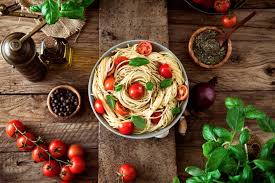Italian food the most popular ethnic food in America

Rome: Many Italian foods are so familiar they almost seem like American foods. If you ask a child where pizza is from, he is likely to say the United States. And the same goes for spaghetti and lasagna. Gelato, too. No wonder Italian food is still the most popular ethnic food in America.
So it was natural — inevitable, really — that I would wrap up my yearlong culinary tour of other countries with a visit to Italy, the best-tasting boot in the world.
The country is marvelously varied in the cuisine of its different regions. Southern Italy provides the food that is perhaps most familiar to Americans. It is where you will find the tomatoes, the eggplants, the marinara sauce — and the pizza.
Northern Italy is more about beef and dairy; it is home to the butter-based sauces and the cream. It is also the birthplace of salted meats, such as prosciutto and salami.
With such an extraordinary abundance of foods and styles of cooking, I was briefly at a loss for what to choose that would best represent the Italian kitchen. I decided to go for dishes that were well-known and comforting, largely because I had an ace in the hole: my wife.
Actually, it is my wife’s late mother, who was the daughter of Italian immigrants and who was said to be a wonderful cook. I decided to make two of her best recipes, and then two from a cookbook called “The Silver Spoon,” which is essentially the Italian version of “Joy of Cooking.” It’s found in kitchens all throughout Italy.
Italian cooking begins with a good tomato sauce, and my wife’s mother’s is absolutely the very best. There is no room for debate here.
In recent years, brightly flavored, fresh-tasting tomato sauces have been the rage, and a lot of home cooks have forgotten all about the old-school, long-simmered sauces. These take some time to make, but every passing minute only deepens and enriches the flavor. This is the way Italians have been making sauce for centuries.
The version I made is so spectacularly good because of a few special techniques. First, it is made with meat: a large hunk of beef and a somewhat smaller hunk of pork. Both boost the lower notes of the sauce and provide an umami undertone. After the sauce has finished cooking, they can be served separately with a bit of the sauce, or part of the meat can be shredded or cut into pieces and kept in the sauce.
The pork adds sweetness to the sauce as well, which is important because this sauce is made without sugar. The sweetness, which is just enough to counteract the tomatoes’ acidity, is an integral part of the sauce and is not merely added for its own sake.
And to keep the sauce from becoming bitter, tomato paste is added only toward the end of cooking. Tomato paste can become unpleasantly harsh if it cooks for too long, so it is only stirred into the sauce for the last half-hour.
One more trick to the sauce: It has no oregano at all. Apparently, that’s a Northern Italian thing.
Once the sauce was made, I could use some of it to make stuffed shells. This is one of our most popular dinner-party dishes for the very good reason that it is utterly magnificent. It starts with the sauce and only gets better from there.
What makes it better is the mixture that is used to stuff the pasta shells. It is nothing fancy, nothing special. Just the absolutely perfect proportion of fresh ingredients.
You begin with a lot of parsley and a little garlic, which you keep chopping (and chopping, and chopping) until it almost forms a paste. This is mixed with rich, almost sweet ricotta cheese, along with a couple of eggs, a splash of olive oil, a healthy handful of grated Parmesan cheese and a bit of nutmeg which, my wife’s mother wrote on her recipe card, “gives it (an) exotic taste.”
The filling is stuffed into parboiled pasta shells that are covered with the sauce, baked and served piping hot. Although the dish is casual in nature, it never fails to impress everyone who tries it.
I next decided to make what is perhaps the ultimate Italian comfort food. Pasta e Fagioli, which is pronounced by Southern Italians as “pasta fazool,” is a simple dish of pasta and white beans; it is just about the most inexpensive meal you can make.
Inexpensive, yes, but warming and inexpressibly wonderful. About half of the beans are pureed, which creates a nicely rustic texture, and the pasta is cooked in that puree (with a lot of water), allowing it to draw in all of those great flavors.
To millions of Italians, it says “home.” To millions of people who are not Italian, it says, “Wow, this is really, shockingly good.”
For dessert, I made what may be the most popular Italian dessert, zabaglione. It is like a custard, but technically it isn’t one (no dairy); in fact, it is an emulsion. But that is an ugly word for a dessert that is so light and airy and delightful.
It is also easy, as long as you don’t mind a lot of whisking. Zabaglione has just three ingredients: egg yolks, sugar (I used superfine sugar) and Marsala wine. Marsala is the traditional choice, but other sweetened wines, or even sparkling wines, will do.
All you do is whisk together the yolks and the sugar until frothy, add the wine and then whisk that mixture over lightly simmering water until it magically begins to coalesce and grow. It becomes as light as a feather, and almost effervescent.





